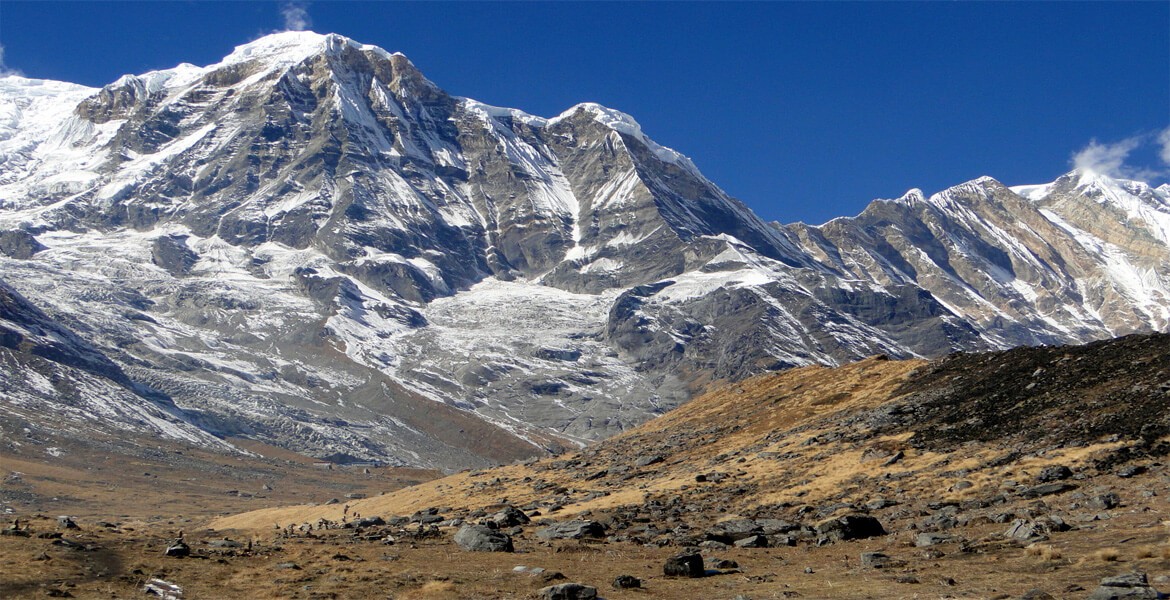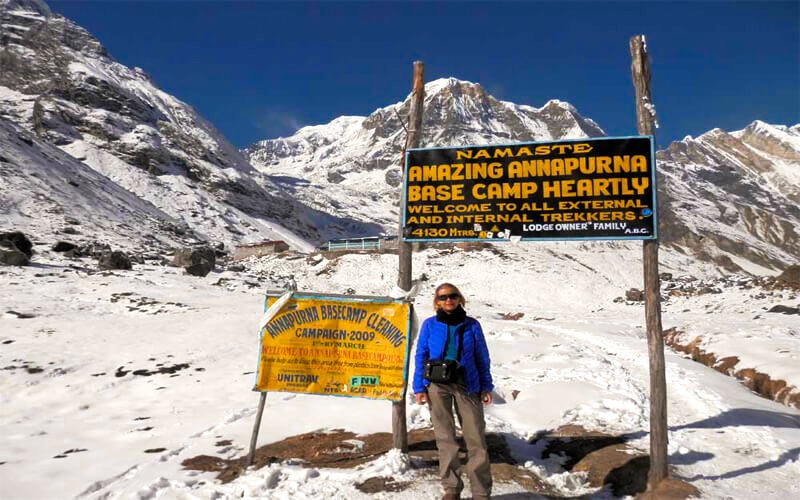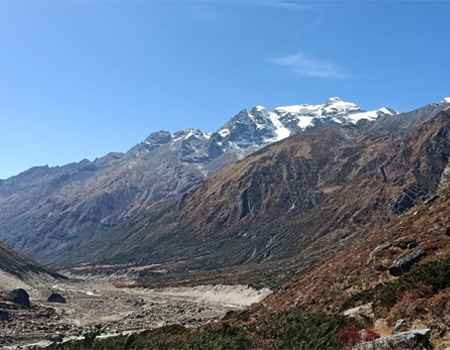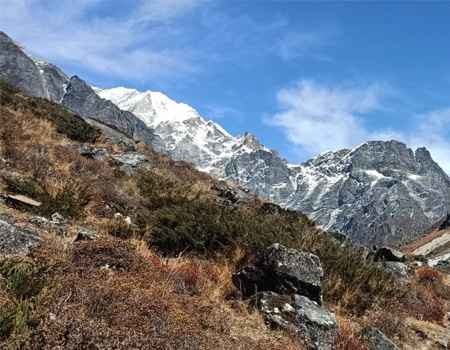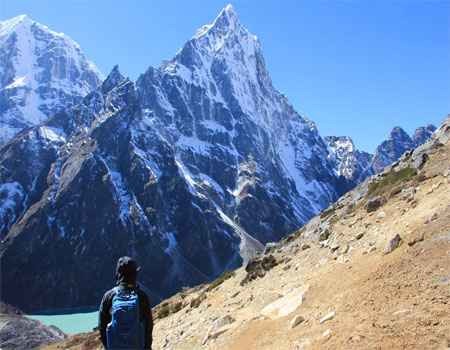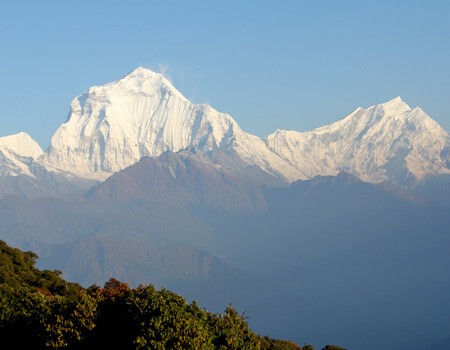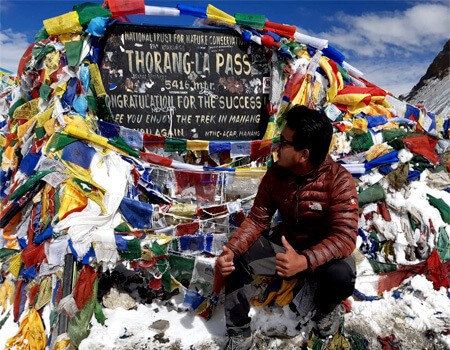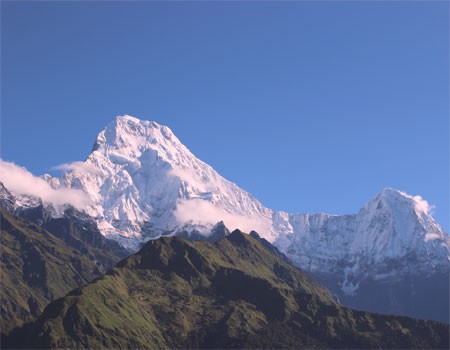When is the Best Time for 7 Day Annapurna Base Camp Trek?
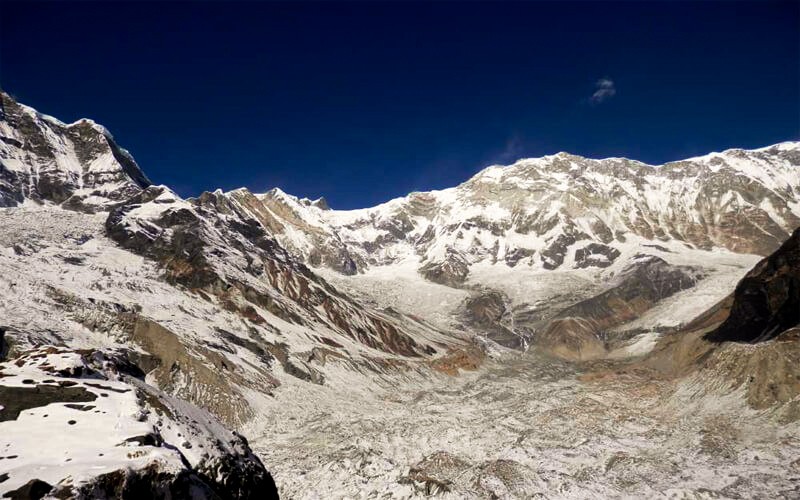
Annapurna I (8091m)
The Best Time for the "Annapurna Base Camp Trek 7 Days" is from September to November in the Autumn and March to May in the spring.
Autumn (September-November)
The warm and dry autumn weather is perfect for Trekking. The clear blue skies and snow-capped mountains are the trek's highlights, and the festive atmosphere adds to its attraction. The daytime temperatures are perfect for Trekking.
Spring (March-May)
The Annapurna Region looks its best in the spring. Rhododendrons and other wildflowers bloom in the region, turning the hills pink and red and the dry leaves green. The region's green landscapes will enthrall you, and the majestic views of the Machhapuchhre and Annapurna ranges of mountains will spellbind you.
The summers in the Himalayan region are wet, and the temperature decreases below 0 degrees in the winter. Trekking the area in these off-seasons presents many challenges. Heavy rainfall in the monsoon season makes the trails slippery. There are also chances of landslides and increased leeches around the area.
Autumn and spring are ideal months to trek to Annapurna Base Camp. However, proper packing and preparation make the trek manageable all year.
Related:
- Ghorepani Poon hill trek
- Mardi Himal Trek
- Mohare Danda Trek
- Khopra Danda Trek
Contact us if you have any information regarding the trek. How difficult is the Annapurna Base Camp Trek, which takes seven Days?
The "Annapurna Base Camp Trek 7 Days" is quite challenging. If you are a beginner, the trail can be pretty tricky. At high altitudes, oxygen levels decrease rapidly, causing Altitude sickness in trekkers.
The process of breathing gets highly difficult for trekkers. Thus acclimatization is the key to such high-altitude Treks. Descending to a lower altitude is necessary, along with hydrating regularly. The primary key is to go slow, rest, and hydrate regularly.
Expert trekkers recommend not rushing. The total distance of the treks is approximately 115 kilometers, and you will walk for an average of 5-7 days. The distance and duration of the Trekkan will be quite taxing. The Annapurna Base Camp 7 Days Trek also demands a basic fitness level.
A basic training regime helps beginner trekkers immensely. The difficulty level of the trek also hiring a trekking guide increases according to the seasons and the time you choose to trek. The treks are covered in snow in winter, and the temperature can fall below 0 degrees.
Why Trek the Annapurna Region?
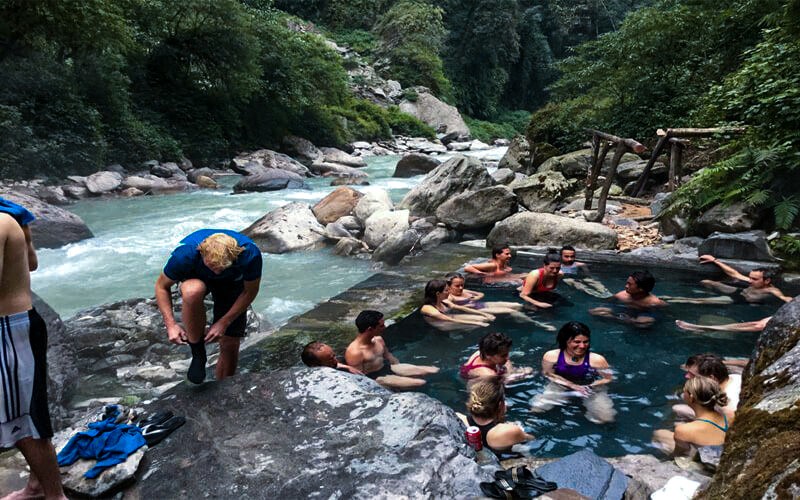
Jhinu hot spring
Scenic mountain landscapes
You can observe the beautiful Annapurna, Manaslu, Dhaulagiri, and other ranges of mountains from various vantage points on the trek. The breathtaking panoramic sunrise is one of the major highlights of the trek.
The golden sun rays falling upon the silver mountains is a once-in-a-lifetime experience. In spring, the wildflowers and wild rhododendron bloom all over the hills.
Diverse flora and fauna
The Annapurna region has diverse flora and fauna; you can spot rare wildlife. The green vegetation and vast landscapes are the primary attractions of the trek.
The beautiful Annapurna Region has abundant wildlife and plants protected under the Annapurna Conservation Project. The picturesque Annapurna Region has a vibrant natural beauty, which makes it very appealing.
Cultural exploration of the community
The Annapurna Region also allows us to explore its culture, tradition, and heritage. The Gurung, Tamang, and Sherpa communities and their Tibetan Buddhists inspired significant heritage highlights of the trek.
Buddhist heritage and monuments cover most trails, including mani walls and chortens. Many festivals, including Lhosar, Dashain, Tihar, etc., occur annually. Another aspect of the 7-Day Annapurna Base Camp Trek is the incredible hospitality of the local people.
Six Essential Tips for Annapurna Base Camp Trek 7 Days
Acclimatize and hydrate regularly.
The Annapurna Base Camp Trek in 7 Days is a high-altitude Trek. Decreasing oxygen levels can lead to altitude sickness, which can be coped with through proper acclimatization and regular hydration.
You should maintain a slow and steady pace, which will help your body relax, increase oxygen levels, and adapt to high-altitude conditions.
Prepare and pack appropriately.
Proper packing and adequate preparation are necessary while Trekking in high-altitude regions. Appropriate clothes are best, as the Annapurna Region can get notoriously cold in the mornings and at night.
You should also dress in layers to add or remove clothing if necessary. In addition, you should carry trekking shoes, clothes, thermals, sleeping bags, ski goggles, gloves, emergency lights, down jackets, and other necessary items.
Start your trtrekarly.
The best advice is to start your trek early each morning. The treks can take longer than expected, and you might need regular breaks. The weather may also be unfavorable.
The trek takes an average of 7-8 hours, and an early start will ensure that you arrive at your destination before dark.
Hire a guide and a porter.
We recommend hiring a trekking guide to help you quickly find your trail and understand the local culture and tradition. A guide is necessary because trekkers can get lost in adverse weather conditions.
The guide is also your helping hand in case of any emergencies. A porter helps you to share the weight of your heavy luggage. Some guides also work as porters.
Get Proper training and a balanced diet.
Before trekking to the Annapurna Base Camp, you must establish a porter regime camp, which will help you increase your fitness and stamina for the seven-day trek.
Trekkers should also eat a balanced diet and take regular breaks. Their training should include cardiovascular activities like hiking, cycling, swimming, etc. These activities help them gain fitness and increase stamina.
Get a Travel Insurance
Travel Insurance is necessary when Trekking in high-altitude regions, such as the seven-day Annapurna Base Camp Trek. Travel insurance covers injuries, flight cancellations, helicopter evacuation, and other expenses. If you experience severe altitude sickness, you might need helicopter evacuation, which costs around $5000 to $10,000.
Travel Insurance also helps you remain stress-free and enjoy your trek. Hence, those Trekking in high-altitude regions must consider getting good coverage.
Annapurna Base Camp Trek 7 Days Packing List
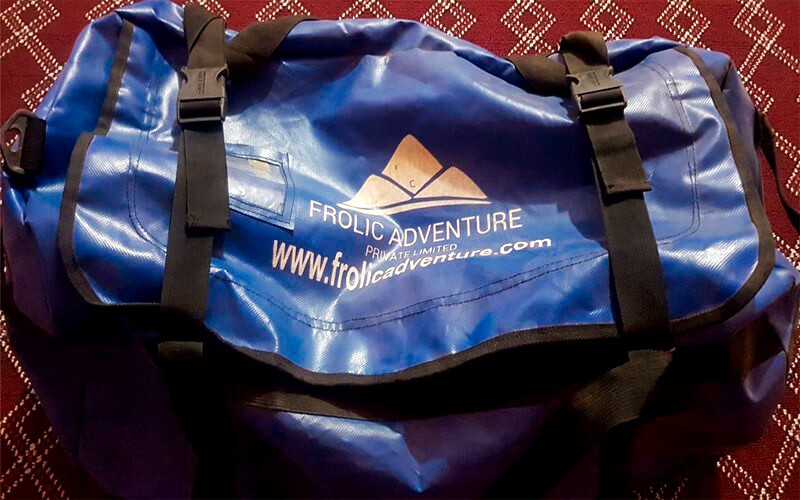
Trekking gear packing bag
The Annapurna Base Camp of 7 Days requires a great deal of packing. The items you need to pack also depend upon the time at which you are planning to trek, the essential items you need to pack are as follows:
Clothing
- Trekking pants and jackets
- Trekking boots
- Lightweight Sweaters
- Thermals underwear
- Trekking Gloves
- Woolen caps/ beanies
- Short-sleeved trekking shirts
- Long-sleeved trekking shirts
- Insulating jackets
- Fleece-lined jacket
- Rain covers/ Umbrella
First Aid
- Anti-nausea Medicines
- Band-aids
- Diamox tablets
- Sanitary pads/ Tampons
- Oral rehydration salts
- Mosquito repellent spray or ointment
Toiletries
- Toilet Paper
- Moisturizer
- Shampoo
- Soap
- Sunscreen
- Hand sanitizer
Accessories
- Cameras
- Sleeping bag
- Sunglasses
- Hot water Thermos
- Water Bottle
- Solar Chargers
- Extra Batteries
Important Documents
Annapurna Base Camp Trek 7 days Itinerary
Day 01: Kathmandu or Pokhara - Nayapul - Ghandruk
Maximum altitude: Ghandruk (2020m)
Drive duration: 6-7 hours (from Kathmandu) or 1.5 hours (from Pokhara)
Trek duration: 1 hour
We start with a scenic drive from Kathmandu or Pokhara to Nayapul. The trip takes about 6-7 hours from Kathmandu and 1-2 hours from Pokhara. After arriving at Nayapul, we will start our trekking journey to Ghandruk.
The one-hour Trek to Ghandruk village passes through pristine forests. We stay overnight at a homestay in Ghandruk village.
Day 02: Ghandruk - Chhomrong - Sinuwa
Maximum altitude: Sinuwa (2340 m)
Trek duration: 5-6 hours
After a delicious homemade breakfast at Ghandruk, we start our trek and continue through lush alpine forests to arrive at Chhomrong Village.
The local Gurung culture, heritage, and tradition in Ghandruk and Chhomrong are worth exploring. After lunch, we resume our trail to Sinuwa, where we stay overnight at a lodge.
Day 03: Sinuwa - Bamboo - Dovan - Himalaya - Deurali
Maximum altitude: Deurali (3200 m)
Trek duration: 6-7 hours
After breakfast, we start our trek to Sinuwa, passing through the Bamboo, Dovan, and Himalayan bamboo forests to Deurali. We observe beautiful views of the snow-capped mountains and green hills.
We take a lunch break at BaBamboond, then resume our TBamboo Deurali, which takes about 6 to 7 hours. The uphill trail is laden with incredible flora and fauna. We stay overnight at the lodge in Deurali.
Day 04: Deurali - MBC - Annapurna Base Camp
Maximum altitude: Annapurna Base Camp (4130 m)
Trek duration: 5-6 hours
After breakfast, we trek to the stunning Annapurna Base Camp, our primary destination. Reaching Annapurna Base Camp from Deurali takes almost 5 to 6 hours.
We will pass through the beautiful Machhapuchhre Base Camp (MBC). The magnificent views of Machhapuchhre (Fishtail), Annapurna III, Annapurna South, Himchuli, Glacier Dom, Gandharva Chuli, Gangapurna, and others will spellbind us.
You can observe a stunning Himalayan sunset at the Annapurna Base Camp Region. You will stay overnight at a Camp.
Day 05: Annapurna Base Camp - MBC - Deurali - Himalaya - Dovan - Bamboo
Maximum altitude: Annapurna Base Camp (4130 m)
Trek duration: 5-6 hours
We wake up early to observe the most incredible sunrise over the Himalayan vista of Annapurna I, Annapurna South, Tent Peak, Himchuli, Barahi Shikhar, and Gandharvachuli.
After breakfast, we start our return trek, passing through the MBC, Deurali, Himalayan, and Dovan before finally arriving at Bamboo.
Day 06: Bamboo - SinBambooChhomrong - Jhinu - Kyumi
Maximum altitude: Bamboo (2340m)
Trek duration: 5-6 hours
After breakfast, we start our trek passing through the settlements of Jhinu via Sinuwa and Chhomrong. We have lunch at Jhinu, which is located at a height of 1,690m.
You can also dip in the hot springs of Jhinu Danda. After lunch, we resume our trek and, after 6 hours of walking, arrive at Kyumi. We stay overnight at a lodge in Kyumi.
Day 07: Kyumi - Siwai - Nayapul – Pokhara or Kathmandu
Maximum altitude: Kyumi (1690m)
Trek duration: 5-6 hours
Drive duration: 6-7 hours (to Kathmandu) or 1.5 hours (to Pokhara)
After breakfast, we trek briefly to Nayapul via Siwai. Our Treks as we drive back to Pokhara and then to Kathmandu.
Famous Region Treks:
- Annapurna Circuit Trek
- Annapurna Base Camp Trek
- Annapurna View Trek
Contact us if you have any information regarding the trek.
